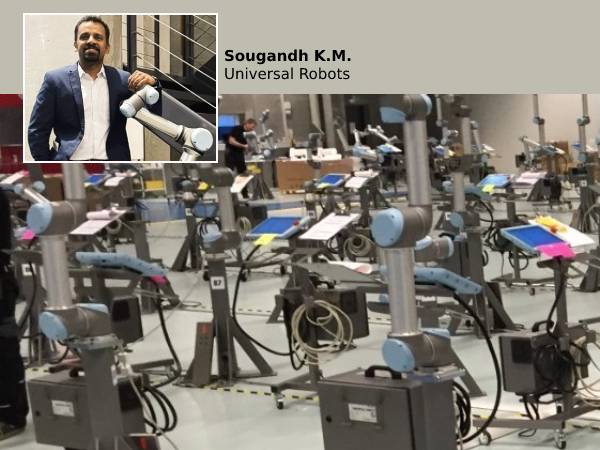
By Sougandh K.M, Country Manager,India, Universal Robots*
September 14,2023: In the ever-evolving landscape of industrial automation, a revolution is unfolding, and at its heart lies a game-changing innovation: collaborative robots, or "cobots."
These versatile machines are reshaping the way we approach tasks previously deemed challenging, monotonous, or even perilous. Among the many roles cobots are taking on, one that stands out prominently is machine tending. As we peer into the future, it becomes evident that cobots will be irreplaceable in this pivotal aspect of manufacturing, delivering efficiency, flexibility, and a safer work environment.
Machine tending involves the loading and unloading of workpieces from machines, a crucial task that has traditionally required human operators to work in close proximity to heavy machinery, posing inherent risks. The repetitive nature of the task, potential exposure to hazardous materials, and the fatigue-induced possibility of human errors have made machine tending ripe for automation. Cobots, as a solution, address these challenges while bringing several significant advantages to the forefront.
One of the most captivating aspects of cobots in machine tending is their innate ability to work collaboratively alongside human operators. This collaborative nature sets cobots apart from traditional industrial robots, which often necessitate dedicated workspaces and extensive safety measures to separate them from human workers. Cobots, on the other hand, are designed with human-robot collaboration in mind. Their built-in safety features, such as force sensors and adaptive control, empower them to detect human presence and instantly adapt their actions to maintain a secure working environment.
The collaborative nature of cobots allows them to assist human workers in tasks that were previously considered too risky or physically demanding. Machine tending, which entails lifting heavy workpieces, repetitive actions, and the need for precision, perfectly exemplifies this scenario. Cobots can handle the repetitive aspects of machine tending, significantly reducing the physical strain on human operators and minimizing the risk of injuries caused by repetitive motion.
Furthermore, cobots exhibit remarkable precision and consistency, rendering them ideal for repetitive tasks. A machine tending cobot can load and unload workpieces with pinpoint accuracy, reducing material wastage and ensuring consistent product quality. This level of precision holds particular significance in industries where even the slightest deviation can lead to product defects or production delays.
The flexibility that cobots bring to machine tending is yet another striking advantage. Cobots are easily programmable and re-programmable, allowing them to adapt to different tasks and work seamlessly. This adaptability is crucial in modern manufacturing, where product lines evolve rapidly, and customization is the norm. Cobots can transition effortlessly from one task to another, enabling manufacturers to optimize their production processes with minimal downtime.
The integration of artificial intelligence (AI) further enhances the capabilities of cobots in machine tending. Machine learning algorithms empower cobots to learn from their interactions, resulting in continuous improvement in their performance. They can analyze data, discern patterns, and make real-time adjustments to optimize their actions. This adaptive intelligence ensures that cobots become even more efficient and effective over time, cementing their status as indispensable members of the workforce.
As we glimpse into the future of machine tending, we see cobots taking on increasingly complex tasks. Their ability to handle intricate setups, manage multiple machines, and interact with various workpieces will continue to expand. This versatility extends the realm of automation to industries that were previously challenging to automate fully. With cobots as partners, even small and medium-sized enterprises can harness the benefits of automation without requiring extensive infrastructure changes.
It's crucial to emphasize that the rise of cobots in machine tending doesn't imply the replacement of human workers. Quite the contrary, cobots empower human workers to focus on more strategic, creative, and complex aspects of production. By offloading repetitive and physically demanding tasks to cobots, human operators can channel their skills towards higher-value activities, fueling innovation and problem-solving within the organization.
The future of machine tending is closely intertwined with the ascent of cobots as indispensable workforce partners. These collaborative robots bring safety, precision, flexibility, and adaptive intelligence to machine tending, fundamentally transforming the manufacturing landscape. As cobot technology continues to evolve, we can anticipate them playing an even more pivotal role in shaping the future of production, driving efficiency, and fostering a safer and more productive work environment for all. The collaborative future of machine tending is indeed here, and cobots are leading the way.
*Universal Robots is at the forefront of technology, enabling Human-Robot collaboration that makes industrial automation safe, easy, and accessible for businesses of all sizes, who are able to automate and streamline repetitive industrial processes.